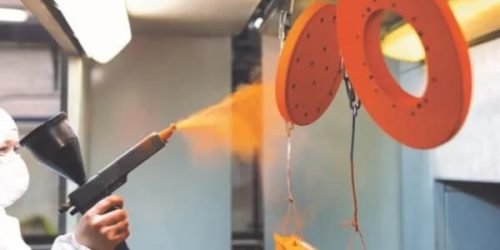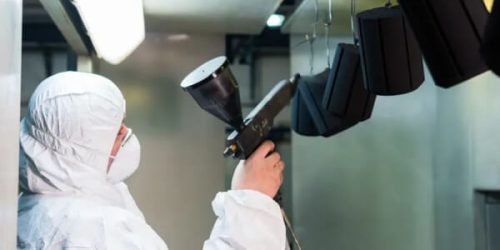Powder Coating Guide: Processes, Types, and Benefits
Powder coating is a high-performance surface finishing technique widely used across industries for its durability, aesthetic appeal, and eco-friendliness.
This guide will explain what powder coating is, how it works, its process steps, types, benefits, quality factors, and comparisons with other finishes.
- Uniform Coverage: Ensures even coating on complex shapes without drips.
- Heat and Chemical Resistance: Resists high temperatures, chemicals, and UV exposure.
- Exceptional Durability: Provides a tough, scratch- and chip-resistant finish for long-lasting protection.
What is Powder Coating?
Powder coating is a dry finishing process in which fine resin and pigment powders are electrostatically charged and sprayed onto a prepared surface. The coated object is then heated in an oven, where the powder melts and forms a durable, uniform, and protective layer.
Unlike liquid paint, powder coating service uses no solvents, producing minimal volatile organic compounds (VOCs) and making it an eco-friendly finishing option. It delivers a high-quality finish that is resistant to scratches, corrosion, and fading, while offering a wide range of colors and textures.
Widely used in industries such as automotive, architecture, appliances, and manufacturing, powder coating combines durability with aesthetic appeal. Its efficiency, environmental benefits, and versatility make it one of the most popular surface treatments in modern manufacturing.

How Powder Coating Works?
Powder coating is an electrostatic process that applies a fine powder to a surface, which is then cured to form a durable finish. The process generally involves three main steps:

Powder Application
Powder coating material, made of pigment and resin, is electrostatically charged in a spray gun. The grounded workpiece attracts the charged powder, ensuring even coverage, including hard-to-reach areas

Adhesion
The charged powder particles cling to the prepared surface due to electrostatic attraction, forming a uniform layer. Proper surface preparation is essential to ensure strong adhesion and a smooth finish.

Curing
The coated part is heated in an oven at a controlled temperature, usually between 160°C and 200°C. The heat melts the powder, allowing it to flow and chemically bond to the surface, forming a tough, smooth, and protective coating.
This process creates a consistent finish that is resistant to scratches, corrosion, and fading, making powder coating a preferred method for both functional and decorative applications.
Powder Coating Process
Surface Preparation
Surface preparation is a critical step. Proper cleaning and pretreatment ensure the coating adheres strongly and lasts longer. Methods include:
Degreasing to remove oils and contaminants.
Abrasive blasting to remove oxidation and create surface texture.
Chemical pretreatment for corrosion protection and improved adhesion.
A clean, well-prepared surface is essential for preventing defects such as bubbling or peeling.
Powder Application Methods
Common application methods include:
Electrostatic Spray – The most common method, offering excellent control, minimal waste, and suitability for complex shapes.
Fluidized Bed Coating – Used for thicker coatings or parts with simple shapes. The heated object is dipped into a bed of fluidized powder particles, which adhere upon contact.
Electrostatic Fluidized Bed – Combines advantages of electrostatic charging and fluidized beds for specialized applications.
Curing Process
Curing transforms the dry powder into a solid film. The coated part is placed in a convection or infrared oven. Key parameters include temperature (varies by powder type—thermoplastics need 120–180°C, thermosets 160–200°C) and time (10–30 minutes). Over-curing can cause discoloration or brittleness; under-curing leads to poor adhesion. After curing, the part cools to form a hard, scratch-resistant finish.
Types of Powder Coating

Thermoplastic Powders
Thermoplastic powders soften when heated and harden upon cooling without undergoing chemical changes. They can be remelted multiple times and are highly resistant to impact and wear. They are often used for protective coatings on automotive parts, household appliances, and plumbing fittings.
Thermoset Powders
Thermoset powders undergo a chemical reaction during curing, forming a cross-linked structure that provides superior hardness and chemical resistance. Thermoset coatings are widely used for industrial equipment, outdoor structures, and automotive components requiring durability under harsh conditions.
Benefits of Powder Coating
Durability and Corrosion Resistance
Powder coatings form thicker, tougher layers than liquid coatings, providing exceptional resistance to scratches, UV fading, corrosion, and chemical attack. This makes them ideal for outdoor and industrial applications.
Eco-Friendly and Low Waste
Powder coating produces no VOCs, contains no solvents, and allows overspray to be collected and reused, significantly reducing environmental impact.
Cost-Effectiveness
Powder coating reduces material waste and rework. Though the initial equipment cost is higher than wet painting, the long-term savings from durability and reduced maintenance make it cost-efficient.
Aesthetic Variety
Powder coating colors come in a broad palette of colors and textures, including smooth, matte, gloss, metallic, and textured finishes. This variety enables designers and engineers to achieve both functional and aesthetic goals.
Factors That Affect Powder Coating Quality
▶ Material Type and Surface Condition
Surface preparation is crucial. Different metals and alloys require specific pretreatments to ensure proper adhesion and corrosion resistance.
▶ Coating Thickness
A coating that is too thin will not provide sufficient protection; too thick can lead to defects like orange peel texture or cracking. Achieving consistent thickness requires precise equipment calibration.


▶ Oven Temperature and Curing Time
Temperature and curing time directly impact adhesion and finish. Different powders have different curing requirements, so following manufacturer specifications is critical
▶ Environmental Conditions
Humidity, dust, and temperature in the application environment affect coating adhesion and appearance. Controlled environments yield the best results.
Powder Coating vs. Other Finishes
Powder Coating vs. Wet Painting
| Feature | Powder Coating | Wet Painting |
|---|---|---|
| Durability | Excellent | Good |
| Environmental Impact | Low (VOC-free) | Higher (contains solvents) |
| Material Utilization | High (>95%) | Lower (60-80%) |
| Application Complexity | Requires specialized equipment | Simpler application |
Powder Coating vs. Anodizing
| Feature | Powder Coating | Anodizing |
|---|---|---|
| Process Type | Applied coating | Surface conversion |
| Color Options | Vast range | Limited (metallic tones) |
| Substrate | Any conductive metal | Primarily aluminum |
| Surface Imperfections | Hides imperfections | Shows base metal texture |
Powder Coating vs. Electroplating
| Feature | Powder Coating | Electroplating |
|---|---|---|
| Purpose | Corrosion protection, color | Wear resistance, metallic appearance |
| Coating Type | Polymeric layer | Thin metal layer |
| Environmental Impact | Low | Higher (hazardous chemicals) |
| Appearance | Matte to high gloss | Metallic sheen |
FAQs About Powder Coating
What does precision powder coating mean?
Precision powder coating refers to achieving tight tolerances and uniform coverage on complex parts. It ensures even coating thickness, smooth finishes, and reliable performance for industrial applications.
How long does powder coating typically last?
With proper preparation and application, powder coating can last 15–20 years or more, depending on environmental exposure and maintenance.
Why is powder coated black a popular choice?
Powder coated black is widely used for its sleek appearance, durability, and versatility. It provides a professional matte or gloss finish that suits furniture, automotive, and architectural applications.
What industries commonly use powder coating?
Powder coating is widely applied in automotive, aerospace, construction, furniture, household appliances, and electronics due to its durability and cost-effectiveness.
Is powder coated aluminum suitable for outdoor use?
Yes, powder coated aluminum is highly resistant to UV light, moisture, and corrosion, making it an excellent choice for outdoor structures, windows, and automotive components.
Can I choose different powder coat colors for my parts?
Yes, powder coating offers a wide variety of powder coat colors, textures, and gloss levels, allowing you to customize both the aesthetic and functional performance of your product.
How does aluminum powder coating differ from anodizing?
Aluminum powder coating creates a thicker, more versatile surface layer with a wider color range, while anodizing enhances the natural oxide layer of aluminum, offering excellent corrosion resistance with a metallic finish.
What are the advantages of using professional powder coating services?
Professional powder coating services ensure consistent quality, advanced equipment usage, proper surface preparation, and durable finishes that resist corrosion, scratches, and fading.
